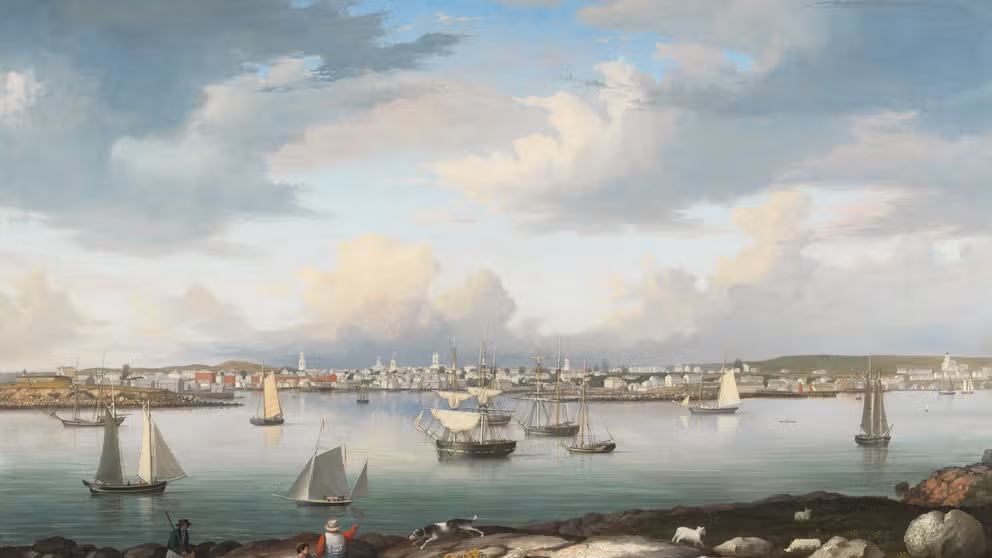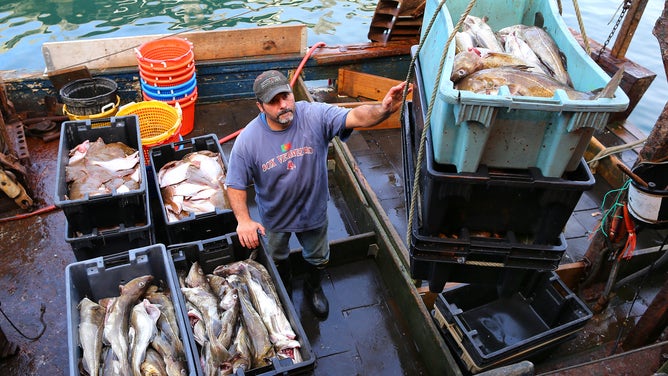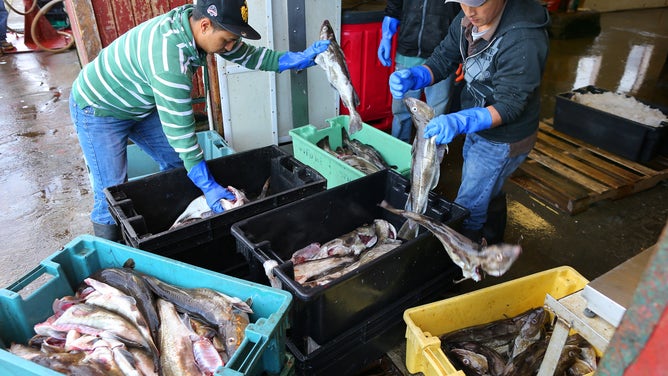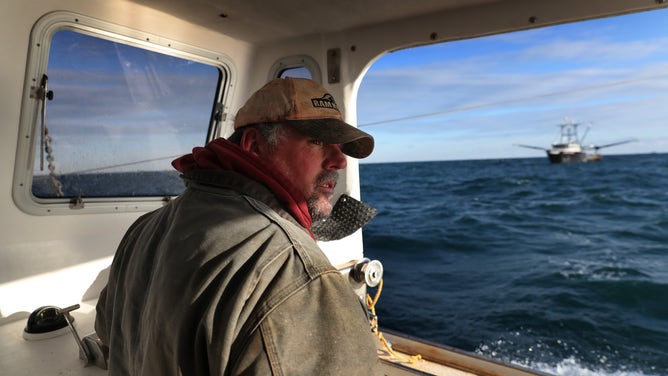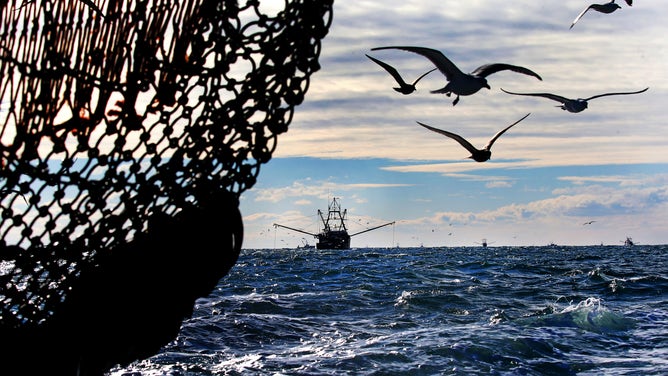How Gloucester honors the Andrea Gail and a fishing legacy spanning over 400 years
The hometown of the fishing crew lost to the “Perfect Storm” in October 1991 has a long and storied past — one that revolves around the highs, heartaches and evolution of the fishing industry.
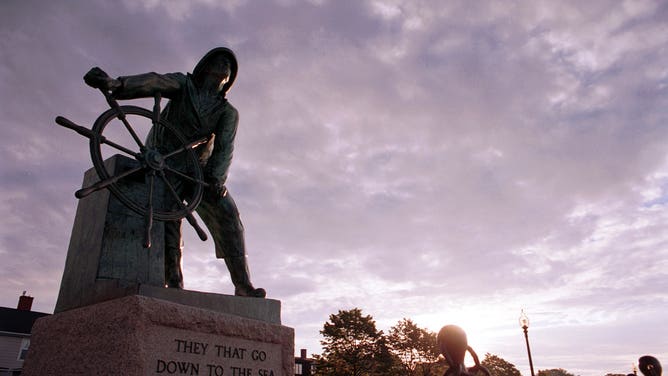
The Fisherman's Memorial Statue in Gloucester, MA.
(Darren McCollester/Newsmakers / Getty Images)
Overlooking the harbor of Gloucester, Massachusetts is a lone fisherman, standing watch for nearly 100 years.
He struggles to remain upright by clinging to the helm of his ship, forever keeping his eyes transfixed on the horizon.
Almost a century of sunrises and sunsets have turned his bronze form into shades of teal, but what he represents remains as unchanged as the blue waters lapping the shore.
While standing alone, he serves as a timeless testament to his brethren, his fellow fishermen lost to the sea.
Early Gloucester
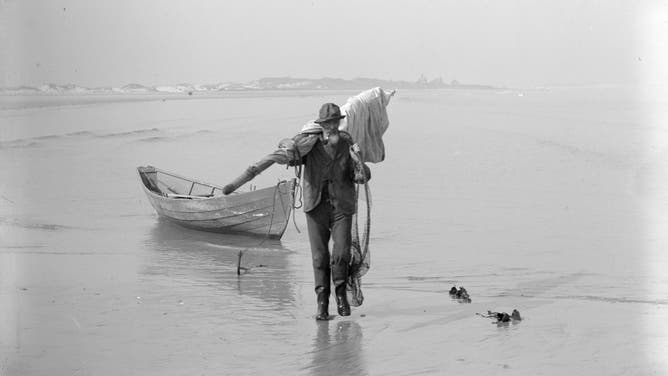
Annisquam dory fisherman Addison Butler, carrying sail, mast and dip net. Coffin's Beach. 1895. Photograph by Martha H. Harvey.
(Cape Ann Museum)
"It's a very longstanding history that this area has with fishing," said Oliver Barker, Director of the Cape Ann Museum in Gloucester (pronounced "GLAHS-tur").
From exhibits about the modern fisherman to the early indigenous groups of the area, the museum represents over 400 years of the history of Cape Ann, the home of the city of Gloucester.
According to the museum’s Maritime Curator Erik Ronnberg, "Gloucester's history really began with fishing and the explorations of French and English fishermen in the 16th century."
Gloucester, MA: the fishing legacy of America's oldest seaport
The hometown of the Andrea Gail fishing crew has a long and storied past.
The settlers found an abundance of fish, many of which were caught and then sent back to Europe. Ronnberg said, this went on for over a century before there were serious attempts to colonize Cape Ann.
One of those early colonial settlements was Gloucester. It was established in 1623, over 150 years before the United States was declared an independent country.
Over the centuries, the city’s story was shaped by the area’s abundance of fish — spawning a fishing industry that the fledgling settlement would later come to dominate.
Feeding the multitude

Ships in Gloucester Harbor, Gloucester, MA., c. 1870s. Photographer unknown.
(Cape Ann Museum)
In the early 18th century, Gloucester was quickly becoming a thriving community, largely due to the success of its fisheries.
This success was brought about by a confluence of factors.
According to Ronnberg, the climate was right for the species that were thriving here, such as cod and flounder, in addition to halibut that was found further offshore.
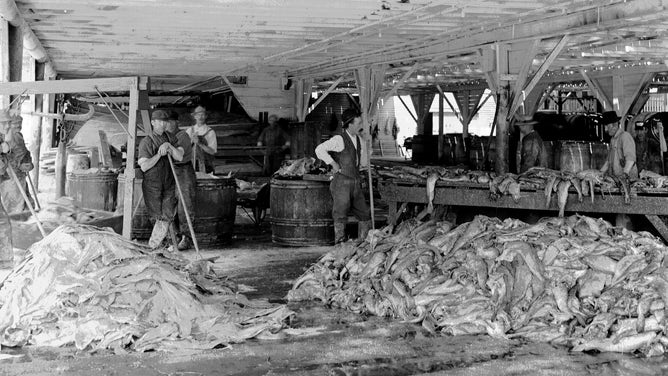
Men processing fish in Gloucester, MA c. 1910. Photograph by H. W. Spooner.
(Cape Ann Museum)
He added that migratory fish like mackerel were also present. They proved a popular alternative to cod, but codfish remained the leading market fish.
The shape and depths of the harbor also played a role. At one point, the harbor was able to accommodate 300-400 schooners, fishing vessels that would come in and out of port on a daily basis.
According to Barker, "The physicality, the location of the harbor itself — from a practical point of view for the fishing industry, it was an important determining factor as to why Gloucester rose to become the largest fishing port in America."

Women packing fish, such as codfish, at Sylvanus Smith & Co. c 1899. Photograph by Herman W. Spooner.
(Cape Ann Museum)
Gloucester’s success also boosted the economies of areas that eventually became the seedlings of the U.S. According to Ronnberg, the prosperous fishing industry of Gloucester "kept the early New England colonies going."
The sons of Gloucester
As the centuries passed, countless more fishing vessels set sail from Gloucester Harbor; but hardly any are as widely known today as the fated Andrea Gail.
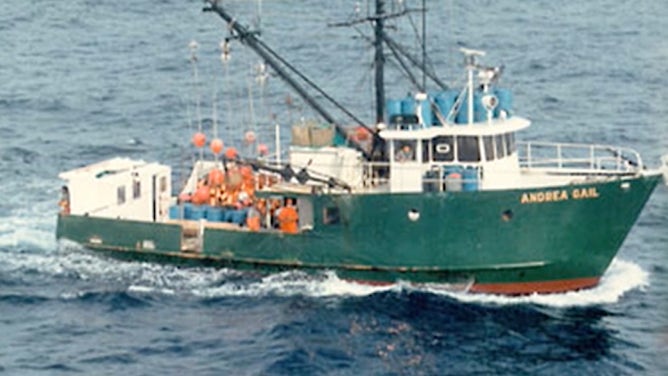
The Andrea Gail fishing vessel.
With six Gloucester fishermen on board, the fishing trawler set out to sea in late October 1991.
"She was unfortunate enough to be caught out in a terrific storm and apparently was simply overpowered by it," said Ronnberg.
The storm would later be referred to as "The Perfect Storm".

A view from Marblehead, MA toward Tinker's Island is pictured during the 1991 "Perfect Storm" on Oct. 30, 1991.
(Michele McDonald/The Boston Globe via Getty Images)
"The Perfect Storm was a combination of multiple weather systems," said Brian Donegan, FOX Weather meteorologist. [Learn more about the Perfect Storm]
According to Donegan, the storm included a powerful non-tropical area of low pressure off Atlantic Canada, the leftovers of former Hurricane Grace, a strong high-pressure system over eastern Canada and the eastern United States, and then a remarkable transition to another hurricane – the so-called "Unnamed Hurricane."
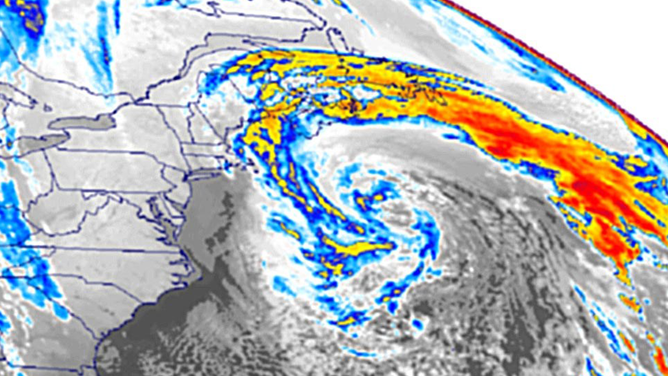
'The Perfect Storm' off the coast of the United States on October 30, 1991
(NOAA)
Where the weather systems converged in the northwest Atlantic was where the Andrea Gail had sailed and later disappeared.
"All hands were lost when she sank," according to Ronnberg.
He added, "In most cases, in recent sinking of fishing vessels, the crew have been rescued when the vessel could not be saved. In this case, it was just a total loss."
"That made it extremely hard on the community."
Storms at sea are nothing new to fishermen and, over the years, their vessels have been made safer and more resistant to storms. This has helped reduce the losses faced by the local community.
"But it just makes it all the more agonizing when something like that happens," said Ronnberg.
They that go down to the sea in ships

The Fisherman’s Memorial Statue looking out to the M.N.t.s. Nantucket in Gloucester, MA. 1930s. Photograph by John C. Adams.
(Cape Ann Museum)
Today, the lone figure in the Gloucester Fisherman’s Memorial continues to pay homage to the fishermen of the Andrea Gail and all other fishing vessels lost at sea.
As the memorial has changed over time, so has the tradition of fishing in Gloucester.
"Fewer vessels are going out and catching fish," said Ronnberg. More and more of the wharves are being turned over to other types of activity, such as restaurants and recreation.
Despite these changes, the fishing tradition that’s been a hallmark of the area for centuries is still very much alive.
The Cape Ann Museum commemorated 75 local fishing families by organizing an exhibit with their photographs. According to Barker, it was a way to bring to light new stories of what it means to fish in Gloucester today.
"It's a great privilege for us as a museum, that we are able to feature what is still a vibrant and thriving industry here and has obviously such a rich history in terms of this particular place, Gloucester and Cape Ann."
